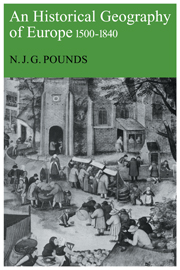Book contents
- Frontmatter
- Contents
- List of maps and diagrams
- List of abbreviations
- Preface
- 1 Europe in the early sixteenth century
- 2 The population of Europe from the sixteenth to the early nineteenth centuries
- 3 The pattern of cities
- 4 Agriculture from the sixteenth to the nineteenth centuries
- 5 Manufacturing and mining
- 6 The pattern of trade
- 7 Europe on the eve of the Industrial Revolution
- Notes
- Index
1 - Europe in the early sixteenth century
Published online by Cambridge University Press: 04 August 2010
- Frontmatter
- Contents
- List of maps and diagrams
- List of abbreviations
- Preface
- 1 Europe in the early sixteenth century
- 2 The population of Europe from the sixteenth to the early nineteenth centuries
- 3 The pattern of cities
- 4 Agriculture from the sixteenth to the nineteenth centuries
- 5 Manufacturing and mining
- 6 The pattern of trade
- 7 Europe on the eve of the Industrial Revolution
- Notes
- Index
Summary
The face of Europe in the early years of the sixteenth century was still in most respects medieval. The horizon of the human mind had expanded; a new world had been brought into existence beyond the Atlantic; authority had been questioned as never before; the printing-press was disseminating knowledge more widely, but the material things of life had changed little since the fourteenth century. The population was still rural and agricultural to the extent of at least 80 per cent, and almost every village settlement existing at this date had been known two centuries earlier. Nor had there been any significant change in the pattern of cities and towns. A few had declined in importance; others had grown in size, but the great majority were still as they had been in the fourteenth century, small and cut off from their fields by defensive walls, but nonetheless closely bound up with the life of the countryside.
Despite the genius of Leonardo da Vinci and the speculations of Copernicus, this was not an age of invention. Ships were increasing in size, and navigational aids were more widely used, but none of these involved any new discovery. Mechanical devices in use at this time had been known for centuries. No advances were made in the use of power beyond the further development and diffusion of the windmill. No new crops were to be introduced until late in the century, and, though the practice of fallowing had been abandoned in a few small areas, as, for example, in the Low Countries, the three-course system of agriculture prevailed almost everywhere, except where a two-field system was still in use.
- Type
- Chapter
- Information
- An Historical Geography of Europe, 1500-1840 , pp. 1 - 66Publisher: Cambridge University PressPrint publication year: 1980



